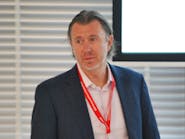Bridging the data-to-knowledge divide in life sciences manufacturing operations
Many life sciences manufacturers are struggling to fill in the gap between data and knowledge. It is a problem born from facilities that rely on connecting existing systems and managing data silos. Meanwhile, as technology is evolving, companies are generating more data but not necessarily a clear direction of how best to use it.
However, the old way of thinking about harnessing data is rapidly changing, according to Shawn Opatka, vice president and general manager of Honeywell Life Sciences. Opatka was joined by Owen Bonner, EMEA pole leader for Honeywell Life Sciences, for a leadership dialogue at the Honeywell Users Group EMEA meeting in The Hague, Netherlands, Nov. 12, when they discussed how the company is handling the emerging shift in their customers’ needs when it comes to turning data into knowledge.
Both said life sciences companies must give their people a better way to translate data into more efficient and productive systems in their facilities. They added that the emergence of artificial intelligence (AI) offers a tool to aid those workers in a way that we have not really seen before.
“AI is here, it’s real, and you can do a lot with it,” Opatka said. “I see a vision when [AI] agents can talk to other agents to translate the data from different places and humans can utilize that knowledge to go deeper into how to use the data.”
He acknowledged that AI often invokes thoughts of replacing workers, but he stressed that the opposite is true. He said it can help people be better at their jobs, and people will be needed even more to decipher the insights that AI can produce from a sea of data in a more efficient and quicker manner.
An innovative approach
Both executives agreed that the old system doesn’t work anymore. Bonner said life sciences are structured in many cases to have separate departments viewing data differently. That’s because the IT and OT worlds are driven by a “don’t touch it and don’t break it” mentally.
However, these days, companies require a much more integrated approach to problem solving that takes many of the traditional IT functions and adds them to the factory floor. That leaves manufacturers living in the gaps between each, so a novel approach and new skill sets are needed.
“It’s not the traditional engineering skills we’ve had in the past,” Bonner said. “We need a different way of building our engineering teams.”
He termed it the “problem-solving organization” and added that industry must use very flexible processes built around how to understand problems, solve them, then in the end deliver the desired outcomes.
Opatka added that managing and deciphering data is no longer just an IT problem but a business problem overall. He reiterated that agents can be used as translators, in effect, between business units to make it easier for everyone to use data to solve problems more quickly and in smaller bits. He said it’s a part of the process that is becoming increasingly necessary because of the nature of siloed data.
“It’s a cross-boundary problem. It could be different owners of the data or different ways of thinking about the data,” he said.
Problem-solving process
When there is a problem to solve, who are you going to call? It’s evident that no single person will usually have the answer, Bonner said. He explained Honeywell has instituted a workshop-driven collaborative process when a customer presents it with a problem to solve, particularly around upgrading ways to manage and better use data.
Honeywell’s process brings in experts to scope out problems, understand them and solve them. Bonner said the key to success is taking the best of the agile information from IT, combining it with the rigors of the life science industry, and thinking very differently about Honeywell’s role as a technology company.
He’s also mindful that life sciences manufacturers must do more with less, or often with the existing systems they have in place. Often that is out of necessity because the nature of their business means that systems can’t be taken offline.
Bonner cited two large pharmaceutical manufacturers with wildly popular drugs who cannot keep up with the production demand as is, so they will not be able to stop production to upgrade systems. “So, they have to work with what they have,” he said.
Opatka summarized the plight of manufacturers living in the gaps between data silos, and the end game for the new way of thinking about systems and structure. “When you think about moving data to knowledge,” he said, “remember we’re recreating an association of data that already exists.”

